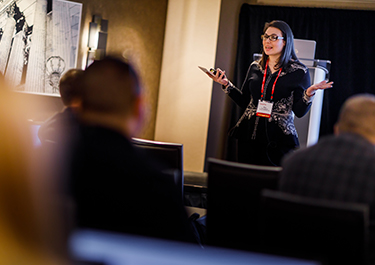 The CompTIA Communities and Councils Forum (CCF) hit Chicago last week; bringing together CompTIA’s highly engaged members for three days of networking, collaboration and knowledge-sharing. This was truly a working meeting – generating ideas, initiatives and insights its attendees can bring straight back to their businesses to fuel growth and innovation. Read on to share what was learned:
The CompTIA Communities and Councils Forum (CCF) hit Chicago last week; bringing together CompTIA’s highly engaged members for three days of networking, collaboration and knowledge-sharing. This was truly a working meeting – generating ideas, initiatives and insights its attendees can bring straight back to their businesses to fuel growth and innovation. Read on to share what was learned:
Rushing to Market is Risky
The IT Security Community meeting at CCF saw a presentation by Lysa Myers, security researcher with ESET, and Jessica Schroder, vendor business development, TBI, asking the question, “What new technologies are negatively impacting security?” Myers, Schroder and attendees threw out emerging technologies such as the Internet of Things, and Myers had an important message on IoT.
“The go-to-market has been move fast and break things,” she said. “As we move into IoT, with things like automated vehicles and food distribution, the consequences [of that approach] could literally be fatal.” So, simply put, we need to slow down – whether we like it or not.
Schroder described the apathy toward cybersecurity that she sees in clients at times. “People think, ‘It won’t happen to me. My stuff isn’t that valuable,’” she said. “Well criminals don’t care,” implying they’ll steal any data they can get their hands on.
Schroder referenced the recently publicized privacy breach at Rush University Medical Center in Chicago. This wasn’t a hack; it was a claims processing vendor improperly disclosing a file containing certain patient information to an unauthorized party in May 2018. Data can slip into the wrong hands in a wide variety of ways, so keeping it locked down is crucial.
Robert Boles, founder and president, BLOKWORX, quipped, “I’m glad someone clarified what Rush is because I was thinking the rock band.”
The Internet of Things is Very Much a Thing
One of CompTIA’s Emerging Technology Community’s key initiatives is ranking the top 10 emerging technologies yearly. Here’s last year’s list. Going into this meeting, the community proposed this new ranking: 1. Internet of Things; 2. AI/machine learning; 3. biometrics; 4. 5G; 5. serverless computing; 6. blockchain; 7. 3-D printing; 8. robotics; 9. drones; 10. AR/VR.
After a spirited debate of that ranking, the community arrived at this new ranking, tabulated from the input of the entire room.
- Internet of Things.
- AI/machine learning.
- 5G.
- Serverless computing.
- Blockchain.
- Robotics.
- Biometrics.
- 3-D printing.
- AR/VR.
- Drones.
It’s interesting to see 5G, which there was some skepticism about last year, surging toward the top, while biometrics moves much further down than the community initially proposed. Drones, ranked seventh last year, is now at the bottom of the list. As it matures, it’s not seen as so urgently emergent anymore. AR/VR, ranked fourth last year, plunges to ninth after being proposed as dead last. The community seems to be concluding this technology is better suited to entertainment than business.
The Internet of Things, meanwhile, sat at the top of the list last year and the top of both the proposed and final lists this year – proof it’s not going anywhere.
Kaizen
In the Managed Services Community meeting, Ryan Goodman, president and partner, ConnectBooster, and Mike Celayeta, VP of operations, TeamLogic IT, presented on executing a one-year process.
This may sound like a simple idea, but Goodman and Celayeta built a lot of high-level thinking into it. They advocated for the use of “kaizen,” which is the Japanese word for improvement. But it’s more than just that; this term has come to represent a process derived from Japanese business practices. It started with automobile manufacturers examining processes on their assembly lines and improving them but then, shortly thereafter examining them again and improving them again – and again. This concept of continual improvement moved outward from the automobile manufacturing sector to other areas of business in Japan and Goodman and Celayeta assert that we should be applying it in advancing the business of technology.
They also prescribe identifying “the quarterly rock” – an objective that should take a quarter to produce.
Moving on to people issues, Goodman and Celayeta challenged attendees to think about times they’ve encountered “a culturally great person who would drop the ball,” asking how long it takes companies to fix such problems. “Not being on the same page on people issues is probably the most disruptive thing,” Goodman said.
Checking Off Boxes
The Advancing Women in Technology Community was tasked with determining how to shape tomorrow’s workforce. Broken into groups by tables, the meeting debated this and came up with “a ha” moments.
One big such moment was a table proposed “taking technology out of the equation” to get more women into IT. An attendee explained that resume-screening software can be biased against women.
Another attendee explained that job listings in general can be biased against women because of core differences in how men and women behave. “Women wait until they have every box in a listing checked off while a man might go, ‘I’ve got 30 percent of this. I’ll go for it!’”
The community agreed the solution here is job listings that move from requirements to desired attributes to encourage more women to enter the tech space.
Fail and Fail Fast
Heather Ptak, director of field marketing with ConnectWise and chair of the Future Leaders Community, led her community through a panel discussion that included Alec Stanners, VP business development, BVoIP; Fabio Vieria, senior channel executive, Lenovo; Paige Reh
HR director, Strategic Communications; and Christopher Fabes; national director of channels Canada, Lenovo.
Ptak asked the panel, “How do future leaders really influence others?”
Vieria said, “It’s building a brand for yourself and having others see that you’re doing something right.”
Reh added, “As young future leaders, it’s really easy to have self-doubt. You have to put yourself out there.”
Fabes said, “Be willing to fail and fail fast because that’s how you learn.” This point resonated with Vieria. “You have to be, at times, vulnerable and uncomfortable,” he said.
The panel identified mentorship as essential for future leaders.
“Mentorship is 100 percent a great thing,” Stanners said. “You’re identifying the assets in your organization.” Reh added that mentorship is “about finding your champions, even in life.”
Don’t Diversify at the Expense of Merit
CompTIA’s Advancing Diversity in Technology Community hosted TED Talks to explore creative ways to accelerate workplace diversity plans. During their meeting, members offered real tips for developing diversity and inclusion strategies, plus ways to expand into unfamiliar social territory.
Kim Thornton of BP shared six secrets to the oil giant’s diversity and inclusion strategies, including partnering with diverse external organizations and understanding what your audience really thinks of you. No matter what your strategy, she said, it will only succeed if you have a meritocratic process.
“There’s nothing worse than bringing in a person who’s not qualified simply because they are diverse,” she said.
Melisa Cameron of AT&T talked about her company’s innovative way to expand into unfamiliar social territory, called D.I.N.E. Developed by AT&T CEO Randall Stephenson, the casual dinner invitations ask people to:
- Discover differences.
- Include one another.
- Navigate new perspectives.
- Eat.
“People learn not just what they have that’s different, but what they have in common,” Cameron said.
Every Day I Write the Book
The Technology Lifecycle Services (TLS) Community will be writing a book this year on the recurring revenue lifecycle and used its meeting to determine its chapters and write its table of contents. Broken into groups, the room produced topics it intends to look at in the book such as how to package your offerings to get monthly recurring revenue; what the respective pricing model needs to be; and discouragement of giving any level of service away for free.
“People strategy is going to be huge in this book,” said Sue Krautbauer, senior vice president, sales and marketing, Techadox, and vice chair of TLS.
All in all, CCF was a great meeting with much in the way of insights and outcomes. Click here to read all about CCF’s opening focus session on the future gap and here to learn more about CCF itself.
 Add CompTIA to your favorite RSS reader
Add CompTIA to your favorite RSS reader

